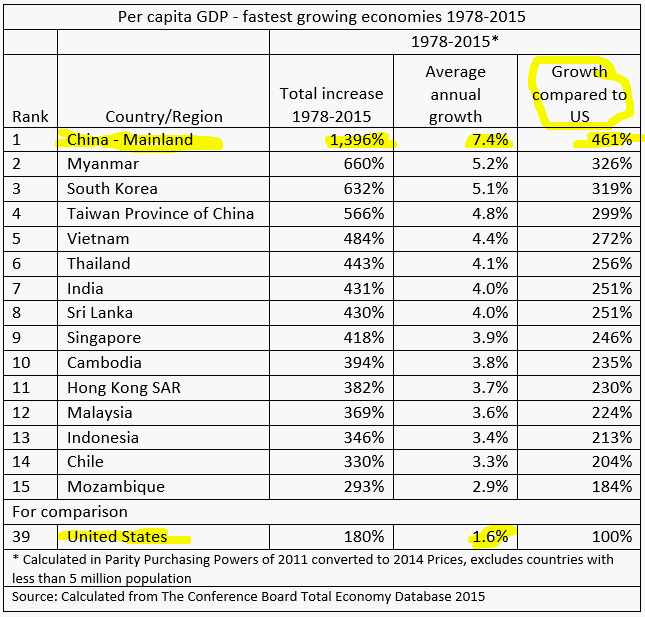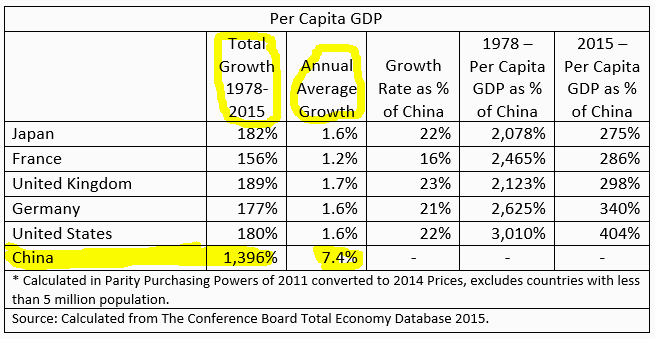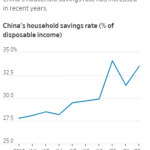China is one of the largest economies in the world with a GDP of over $18.0 Trillion in 2015 based on Purchasing Power Parity. The Per capita GDP is $14,100 and that puts the country at 113 in the world according to CIA’s World Factbook.
The above stats do not however tell how far China has come in terms of economic growth. With a population of over 1.3 billion China used to be one of the poorest countries in the early 20th century. From a rural agricultural-based economy the country has grown exponentially in the past few decades. Though China follows Communism economic reforms helped to to lift millions of poverty.
I recently came across an interesting article by Professor John Ross, Senior Fellow at Chongyang Institute for Financial Studies, Renmin University of China on the economic growth of China. The following table shows the fastest growing economies 1978-2015:
Click to enlarge
Table 1
From the article:
It is also particularly striking that of countries that have gained in per capita GDP compared to the US only a few have gained greatly. Since the beginning of China’s economic reforms in 1978 only six countries or regions with a population of at least five million have closed the gap on the per capita GDP of the US by at least 20% – Mainland China, Malaysia, Taiwan Province of China, Hong Kong SAR, Singapore, and South Korea. All six are in Asia. Of these Mainland China achieved the fastest per capita GDP growth of any country not only in 1978-2015 but over the total period 1950-2015. Four of these economies – the ‘Asian Tigers’ of South Korea, Singapore, Taiwan Province of China, and Hong Kong SAR – all starting from a far higher per capita GDP than Mainland China, have already achieved China’s goal of transition from a ‘low’ or ‘medium’ to a ‘high’ income economy.
Asia’s dominance in rapid growth economies is overwhelming. As Table 1 shows all 10 of the world’s fastest growing economics are Asian – indeed the top 13 are. It is therefore Asian economic development, not the Washington Consensus of the World Bank and IMF, which has been an overwhelming success. It follows that what China has to study to ensure it breaks through to high income status is not the dogmas of the World Bank but the forces which led to China’s own economy outgrowing all others and, after that, what forces produced rapid economic growth in Asia.
Between 1978-2015 China’s total GDP grew by nearly 1,400%. The annual growth rate was 7.4%. This growth rate is much higher than that of other countries including the Asian Tigers.
Indeed China has beat world’s top developed countries in economic growth during the period shown above. Mr.Ross explains the astonishing rate of China’s growth relative to developed countries.
China’s Per capita GDP growth at an annual rate was higher even when compared to advanced economies as shown in the table below:
Table 3
Another excerpt from his article:
Table 3 shows that this fundamental model has not changed. Taking the most important advanced economies over the period 1978-2015, annual average per capita GDP growth was 1.7% in the UK, 1.6% in the US, Germany and Japan, and 1.2% in France. China’s growth was approximately five times as fast as all these economies. The result was China’s catch up in terms of per capita GDP. It may also be clearly noted that the major advanced economies all had essentially the same per capita GDP growth rate of under two per cent – the maximum being 1.7% and the minimum 1.2%. As a result, over the period 1978-2015:
- “China closed the gap in per capita GDP compared to the US from US per capita GDP being 30 times China’s to being four times.
- China closed the gap in per capita GDP compared to Germany from Germany’s per capita GDP being 26 times China’s to under three and a half times.
- China closed the gap in per capita GDP gap compared to the UK from 21 times to under three times.
- China closed the per capita GDP gap compared to France from 25 times to under three times.
- China closed the per capita gap Japan from slightly under 21 times to under three times”.
Source: To become a ‘high income’ economy China needs to study facts not myths. Key Trends in Globalisation, John Ross
While it is common knowledge that the Chinese economy is one of the fastest growing in the world, when looked at a long-term perspective it is fascinating to see the rate of solid economic progress.



